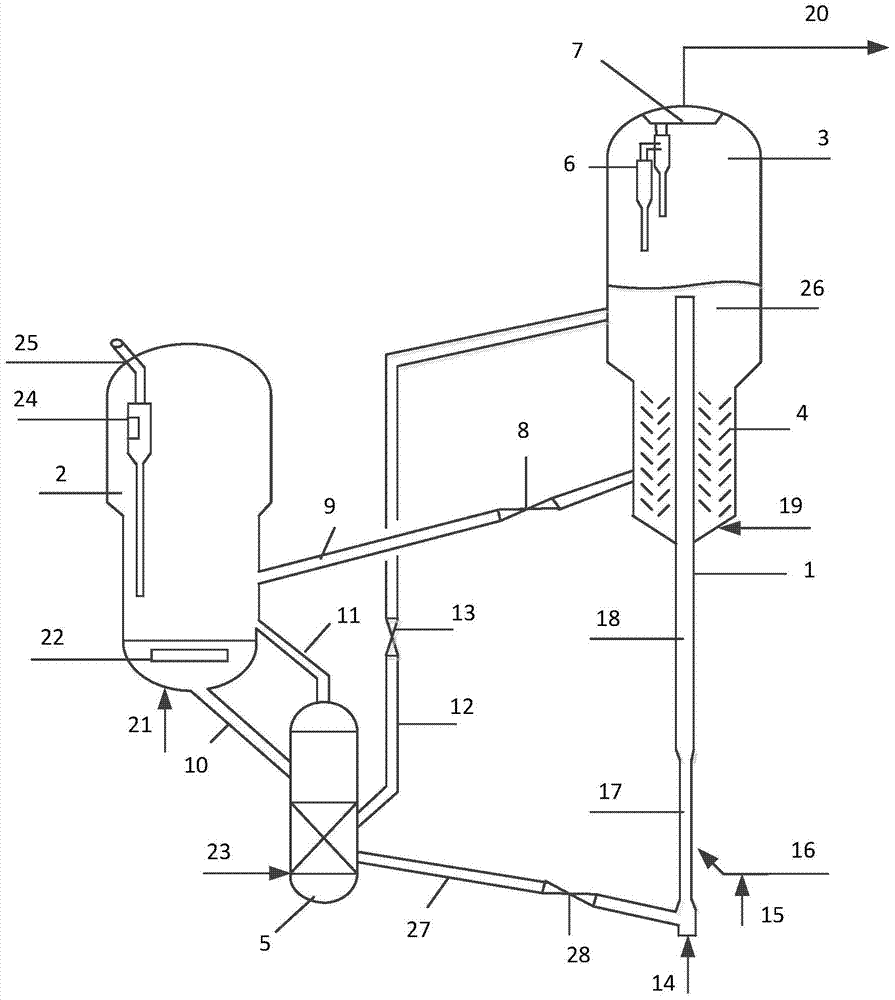A catalytic conversion method for directly processing high-chlorine raw materials
A catalytic conversion and high chlorine technology, applied in the petroleum industry, refining with non-metals, refining with metals, etc., can solve the problems of inability to effectively remove chlorides, achieve improved product selectivity, increase conversion rate, and simple operation Effect
- Summary
- Abstract
- Description
- Claims
- Application Information
AI Technical Summary
Problems solved by technology
Method used
Image
Examples
Embodiment approach
[0067] According to a preferred embodiment of the present invention, the catalytic conversion method comprises the steps of:
[0068] The high-temperature regenerated catalyst is injected into the pre-lift section of the riser reactor, and under the action of the pre-lift medium, it flows upward into the initial reaction zone at the lower part of the riser reactor, and the preheated high-chlorine raw material enters the initial reaction from the lower part of the riser reactor In the zone, it contacts, reacts and goes up with the high-temperature regenerated catalyst; the formed oil mixture enters the main reaction zone of the riser reactor, and continues the hydrocarbon conversion reaction in the main reaction zone; the formed oil mixture enters the fluidized bed The reactor is in contact with the high-temperature regenerated catalyst from the regenerator to continue the hydrocarbon conversion reaction. After the reaction, the stream enters the cyclone separator in the settler...
Embodiment 1
[0086] This example is used to illustrate the catalytic conversion method for directly processing high-chlorine raw materials according to the present invention.
[0087] according to figure 1 The process shown in the test was carried out on a medium-sized catalytic cracking unit. The high-chlorine feedstock oil was preheated to 350°C and injected into the initial reaction zone of the riser reactor through pipeline 15, and was mixed with the high-temperature regenerated catalyst (660°C ) contact reaction in the initial reaction zone, wherein the weight ratio of agent to oil is 6:1, the reaction time is 0.8 seconds, the reaction temperature is 535°C, and the weight ratio of water vapor to high chlorine feedstock oil is 0.05:1. The oil mixture generated in the initial reaction zone continues upward into the main reaction zone to continue the reaction, wherein the reaction temperature is 525°C, the reaction time is 1.5 seconds, and the ratio of the riser diameter of the initial r...
Embodiment 2
[0091] This example is used to illustrate the catalytic conversion method for directly processing high-chlorine raw materials according to the present invention.
[0092] according to figure 1 The process shown in the test was carried out on a medium-sized catalytic cracking unit. The high-chlorine feedstock oil was preheated to 220°C and injected into the initial reaction zone of the riser reactor through pipeline 15, and was mixed with the high-temperature regenerated catalyst (650°C ) contact reaction in the initial reaction zone, wherein the weight ratio of agent to oil is 30:1, the reaction time is 0.2 seconds, the reaction temperature is 560°C, and the weight ratio of water vapor to high chlorine feedstock oil is 0.05:1. The oil mixture generated in the initial reaction zone continues upward into the main reaction zone to continue the reaction. The reaction temperature is 540°C, the reaction time is 3 seconds, and the ratio of the diameter of the riser in the initial rea...
PUM
| Property | Measurement | Unit |
|---|---|---|
| diameter | aaaaa | aaaaa |
| length | aaaaa | aaaaa |
| specific surface area | aaaaa | aaaaa |
Abstract
Description
Claims
Application Information
 Login to View More
Login to View More - R&D
- Intellectual Property
- Life Sciences
- Materials
- Tech Scout
- Unparalleled Data Quality
- Higher Quality Content
- 60% Fewer Hallucinations
Browse by: Latest US Patents, China's latest patents, Technical Efficacy Thesaurus, Application Domain, Technology Topic, Popular Technical Reports.
© 2025 PatSnap. All rights reserved.Legal|Privacy policy|Modern Slavery Act Transparency Statement|Sitemap|About US| Contact US: help@patsnap.com

